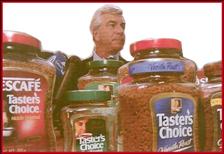Did you ever have the experience of someone walking up to you and telling you that you look just like someone . . ? Most of us at one point or another have had that experience. Well, Russell Christoff was in a store in 2002, when someone came up to him and said he thought he looked just like an image he had seen on a jar of coffee. Perhaps he laughed at that moment, but about a month later, when Mr. Christoff actually saw the jar of Taster’s Choice instant coffee on a shelf – with his recognizable image on the label – he bought the jar of coffee, stopped laughing, and called his agent.

It seems Mr. Christoff, a former model, had posed for a photo shoot for Nestlé (owner of the Taster’s Choice brand) back in 1986 and was paid $250, with the understanding that if the company used his likeness in marketing, he would receive $2,000 in compensation. Thus begins the tale and trail of a legal battle that continues to this day. Mr. Christoff filed suit in 2003 alleging violation by Nestlé of his right of publicity. (California Civil Code § 3344 bars, among other things, unauthorized use of a person’s image for commercial purposes.) The statute allows for damages, punitive damages, the award of attorneys’ fees AND (unlike many other state statutes protecting rights of publicity), profits attributable to the unauthorized use.
As the action unfolded, Mr. Christoff discovered Nestlé’s had begun using his image in 1986. Not only had he never been paid the $2,000, but there was more as well. Much more. It appears that from 1997 to 2003, Nestlé had also used his image on eight different varieties of Taster’s Choice brand labels in 18 different countries, including in Israel, Japan, Kuwait, Mexico, South Korea and the United States. At the trial, a jury concluded that Mr. Christoff should have been paid $330,000 for the use of his likeness and was entitled to damages of more than $15 million! California’s right of publicity statute, as it relates to proof of a defendant’s profits, states that the plaintiff needs to “present proof only of the gross revenue attributable to such use,” (emphasis supplied) while the defendant must prove “deductible expenses.”
In this case, even though the jury determined that only 5 percent of the sales of Taster’s Choice over the period of 1997 – 2006 were attributable to the use of the image, a profitable product and extended use made the jury award substantial, to say the least. Now you would think that the jury verdict in 2005 might have put an end to it, but predictably, Nestlé appealed and the saga continues.
Based on Nestlé’s appeal, the appellate court reversed the jury’s verdict based on the fact that Mr. Christoff had not brought his lawsuit before the statute of limitations had expired; but just this past Monday (Aug. 17), the California Supreme Court ordered the case back down to the trial court to take another look. Why, you may ask? Because the Supreme Court wants the trial court to answer the following question: What’s the correct way to calculate the statute of limitations – start date/end date – in lawsuits involving rights of publicity and product labeling?
Since Mr. Christoff brought his lawsuit six years after Nestlé USA, Inc. began using his image (but less than a year after he discovered it), the original trial court instructed the jury to use a two-year statute of limitation, but to use the point at which Mr. Christoff knew, should have known, or could have reasonably suspected his image was being used on the label, as the starting point for calculating when the statute of limitation would bar his lawsuit. It seems the trial court determined that unlike offensive or defamatory remarks that would not be considered “published” over and over again, simply because they were repeated in 100,000 copies of the same book, the “Single Publication Rule” (Uniform Single Publication Act as codified in Civil Code section 3425.3) did not apply to cases involving the use of someone’s likeness or image. So here’s how the wrinkle unfolds . . .
Continue reading “Rights of Publicity – Wake Up and Smell the Coffee!”

